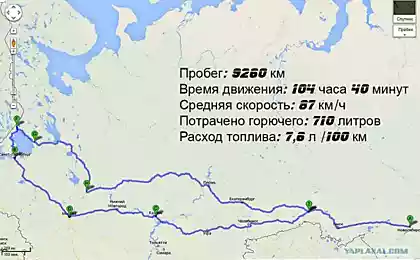979
In Moscow have moved house
Sounds unbelievable, but in the 1930-ies in Moscow, the real boom started moving houses. The architects have implemented large-scale projects, which took place, but it was not. Sometimes the new project was using some kind of brick house.
Most of these houses were destroyed, but there were some buildings that got lucky — they moved to a new location. We chose the most interesting buildings moved and looked as they look now.

Moving houses is not a Soviet innovation: moving architectural structures known for a long time. In 1455 the Italian engineer Aristotle Fioravanti moved the bell tower of the Church of Santa Maria Maggiore in Bologna for a distance of over 10 meters.
The Church prevented the construction of a new building of the city administration, so that the engineer made a tower in a frame of wooden beams, and then moved through a system of ropes and blocks. By the way, later Fioravanti took part in the construction of the assumption Cathedral in Moscow. In Russia, the first experiments on the moving of buildings known before the revolution. In particular, in 1897, in connection with the expansion of the Nikolaev (nowadays October) railway in Moscow was moved a house, which initially wanted to carry.
The building was quite new and belonged to the honorary citizen of Moscow, the owner of a cement plant Evgenia Mak-Gil. The owner decided to demolish the new building to anything, because it can move. And realize this incredible idea of Mak-Gil agreed. The works were supervised by engineer Fedorovich. The building was released from furniture, door and window frames, were also disassembled the furnace, then the workers cut the house and moved it, using horse traction. Method applied later went down in history as a "Method of shifting Yanukovych".
This building was the first brick house that was moved to Moscow. The house still stands at its new location at the following address: Kalanchevskaya street, house 32/61. Unfortunately, now the famous building is abandoned.
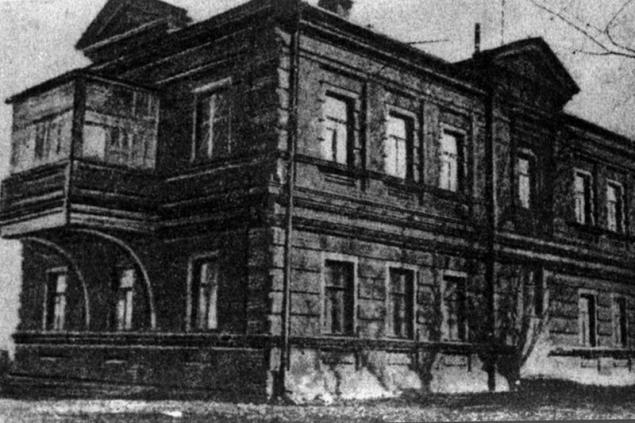
A boom journeys had seized the capital in 1930-ies. Plans to move the buildings were so massive that in 1936 the even was organized by a special office — "Trust in the relocation and disassembly of buildings." He was appointed head engineer E. M. Gendel, known in history as "ascetic".
Employees of the new enterprise were mainly builders, who are faced with similar challenges during the laying of underground tunnels. After that within several decades in Moscow were moved almost 70 homes.
In 1937, the Moscow city planners decided to reconstruct the krasnokholmskiy bridge. The project was ambitious — the bridge was planned not just to rebuild, but also to create new conventions. It turned out that one of the houses that stood at the address: Osipenko street, house 77 (now Sadovnicheskaya street, building 77, building 1), prevents the future construction.
The house had the shape of the letter "G" and part of it was standing just in the place where they were supposed to be built the entrance to the bridge. The building was "young", 1929 year built, therefore it was decided not to demolish and divide into two parts and move one of them, expanding at the same 19 degrees.
The work was complicated by the fact that the house stood on marshy ground, the Foundation gave the drawdown at the stage of construction, which had to drive piles and to deliver the ground. The move was dangerous, the chief of station, who conducted the work, even called him a gamble, but the head of the trust Handel ordered: no matter what, to continue the movement of the building.
This work was the first major order for the trust, and it was successful. Interestingly, during the move, the house occupants are not evicted and did not even shut off utilities: in the apartments continued to operate the water supply, electricity, gas, Sewerage and telephone. All utilities were connected via temporary rubber tube.
The separated buildings were later connected by an Annex that in 1967 there was a major explosion that claimed the lives of 147 people. It happened probably due to subsidence of the soil under the building.
The famous house still exists today, it is still inhabited. Only now the five different address — the street Osipenko was renamed the Horticultural.

In the same year in Moscow has moved another house, which prevented the construction of another bridge — a Large stone. Building on Serafimovicha street, building 5/6 it was necessary not only move, but also to raise to a height of nearly two meters.
The work was carried out successfully: the tenants, as in the case of a house in Osipenko, not evicted. By the way, the transfer of this building formed the basis of the famous poem by Agnes Barto "House moved".
Want — and in a sea of blue,
In the blue sky sail!
You want
And the house move,
If we are stopping the house!
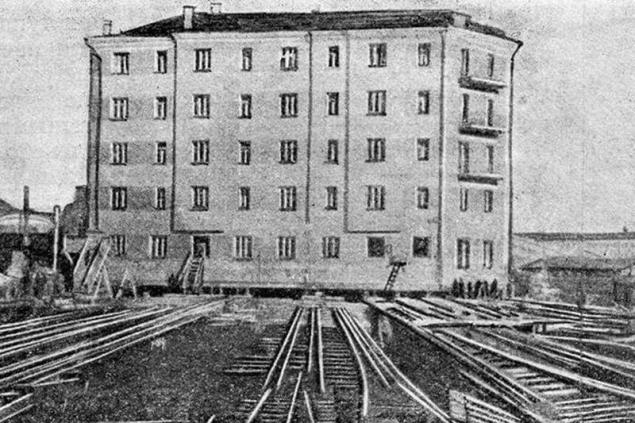
Serafimovicha street, building 5/6
Before moving a building it must be separated from the Foundation. To do this, around the building dug trench, and then by means of wires "cut off" the building from the Foundation. After that, the building was strengthened by special beams, then constructed chassis frame, which has already been put on special rollers. Rollers are moved along pre-laid rails normally used the winch that hauled the building forward, and jacks, which pushed him from behind. The most time-consuming preparatory work, but the actual move happened fairly quickly.
A lot of the buildings were destroyed during the widening of the Gorky street (now Tverskaya). But some of them endure for one reason or another did not. One of the "lucky ones" is a former Savvinskoe PODVOR'e, which now is located at the address: Tverskaya St, house 6, structure 6.
Built in 1907 Savvinskoe PODVOR'e was the most significant and one of the most beautiful buildings on Gorky street. Its facade was faced with glazed tiles and combines elements of art Nouveau and Baroque.
But the implementation of the General plan of reconstruction of Moscow it turned out that the monument is in an awkward place. It was decided to move the house. Moving Savvinskaya farmstead was one of the most difficult works of Handel trust, because the building is "weighed" almost 23 thousand tonnes, which is much more than the houses that was moved before.
Training lasted more than four months, and moved house all in one night. They say that the tenants were worried and requested in advance to warn them about moving the building to enable them to move in with relatives. However, the employees of the trust, confident in the success of the enterprise, specifically pointed out about the timing.
In the end, the relocation is made at night, and she was so smooth that most of the occupants of the house noticed the change of location only in the morning. Still there is a legendary story that during the night moving in one of the apartments even survived a tower of cubes, which in the evening he collected the child.
Today the building is called Savvinskoye Podvorye is hidden in the courtyard of the Stalin buildings that were built around it.

Moscow. 1939. Shifting Savvinskaya farmstead plan the reconstruction of Gorky street
Few people know that in 1940 the movement has undergone and the city Council building, where today is located the city of Moscow (Tverskaya, 13). The iconic structure had to move almost 14 meters in connection with the extension of the street. The uniqueness of the work lies in the fact that the house was moved, together with the basement, while officials continued to work in their offices.
After moving to the city Council building built on two floors, causing the walls went crack. To avoid the destruction, workers had to reinforce the building with steel columns.

The relocation of the city Council, 1939
More complex work is carried out while moving the oldest building in Moscow ophthalmological hospital located on the corner of bitter and Mamonovsky pereulok. It not only removed to the depth of the quarter but turned 97 degrees, causing the facade of the building was in the exit lane.
When traveling in the walls of the hospital did not stop the work — there were doctors, patients, carried out the operation. Today, the building is still eye clinic.

During the great Patriotic war, the moving of buildings stopped — it was necessary to restore the destroyed by bombing houses. However, after the war, such work continued.
For example, in 1979, about 30 yards moved the office home the publisher Sytin, who had stood in the newly constructed building of "Izvestia". The house was moved to the side Astashenkova lane along Gorky street. When you move part of the building was badly damaged.
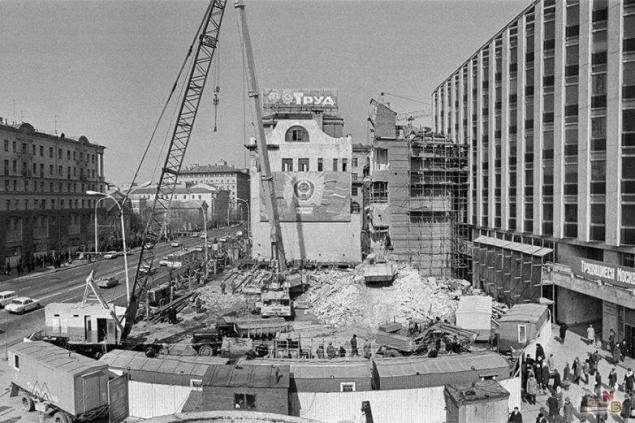
1979. The relocation of the editorial office of the newspaper "Trud" (Sytin Dom) on Gorky street. In the foreground is the place where the house stood
Engineers moved the capital and the building of the Chekhov Moscow art theater. The move was carried out in the framework of reconstruction of the theater in 1983.
The building was divided into two parts: one left the scene and a second auditorium. The stage box was removed, with the result that the hall was enlarged. However, later it turned out that with this arrangement it would be impossible to continue the reconstruction of the theatre as the remaining space was insufficient to install construction equipment. So the stage is first moved nearly 25 meters forward and then was pushed back to 12 meters.
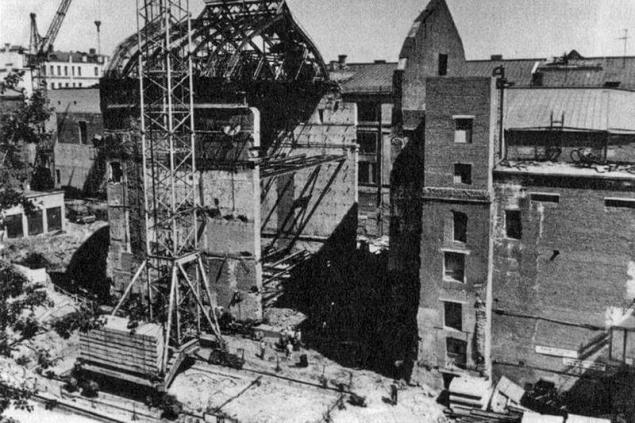
This work became the last major experience in the moving of buildings in Moscow. After perestroika came and money on such projects is no longer isolated.published
SUBSCRIBE to OUR youtube channel that allows you to watch online, download from YouTube free video about the recovery, the rejuvenation of man. Love for others and ourselves, as the feeling of high vibrations — an important factor for improvement
http://cdn00.vidyomani.com/c/0/8/9/vagp3q9cj3nb/index.html
Put LIKES and share with your FRIENDS! https://www.youtube.com/channel/UCXd71u0w04qcwk32c8kY2BA/videos
Subscribe - https://www.facebook.com//
Author: Eugene Kosogorov
Also interesting: every day these huge 8-meter-high statue "passing" through each other
The mystery of the city of Roseto
P. S. And remember, only by changing their consumption — together we change the world! ©
Source: m.moslenta.ru/article/2016/02/11/doma/
Most of these houses were destroyed, but there were some buildings that got lucky — they moved to a new location. We chose the most interesting buildings moved and looked as they look now.

Moving houses is not a Soviet innovation: moving architectural structures known for a long time. In 1455 the Italian engineer Aristotle Fioravanti moved the bell tower of the Church of Santa Maria Maggiore in Bologna for a distance of over 10 meters.
The Church prevented the construction of a new building of the city administration, so that the engineer made a tower in a frame of wooden beams, and then moved through a system of ropes and blocks. By the way, later Fioravanti took part in the construction of the assumption Cathedral in Moscow. In Russia, the first experiments on the moving of buildings known before the revolution. In particular, in 1897, in connection with the expansion of the Nikolaev (nowadays October) railway in Moscow was moved a house, which initially wanted to carry.
The building was quite new and belonged to the honorary citizen of Moscow, the owner of a cement plant Evgenia Mak-Gil. The owner decided to demolish the new building to anything, because it can move. And realize this incredible idea of Mak-Gil agreed. The works were supervised by engineer Fedorovich. The building was released from furniture, door and window frames, were also disassembled the furnace, then the workers cut the house and moved it, using horse traction. Method applied later went down in history as a "Method of shifting Yanukovych".
This building was the first brick house that was moved to Moscow. The house still stands at its new location at the following address: Kalanchevskaya street, house 32/61. Unfortunately, now the famous building is abandoned.

A boom journeys had seized the capital in 1930-ies. Plans to move the buildings were so massive that in 1936 the even was organized by a special office — "Trust in the relocation and disassembly of buildings." He was appointed head engineer E. M. Gendel, known in history as "ascetic".
Employees of the new enterprise were mainly builders, who are faced with similar challenges during the laying of underground tunnels. After that within several decades in Moscow were moved almost 70 homes.
In 1937, the Moscow city planners decided to reconstruct the krasnokholmskiy bridge. The project was ambitious — the bridge was planned not just to rebuild, but also to create new conventions. It turned out that one of the houses that stood at the address: Osipenko street, house 77 (now Sadovnicheskaya street, building 77, building 1), prevents the future construction.
The house had the shape of the letter "G" and part of it was standing just in the place where they were supposed to be built the entrance to the bridge. The building was "young", 1929 year built, therefore it was decided not to demolish and divide into two parts and move one of them, expanding at the same 19 degrees.
The work was complicated by the fact that the house stood on marshy ground, the Foundation gave the drawdown at the stage of construction, which had to drive piles and to deliver the ground. The move was dangerous, the chief of station, who conducted the work, even called him a gamble, but the head of the trust Handel ordered: no matter what, to continue the movement of the building.
This work was the first major order for the trust, and it was successful. Interestingly, during the move, the house occupants are not evicted and did not even shut off utilities: in the apartments continued to operate the water supply, electricity, gas, Sewerage and telephone. All utilities were connected via temporary rubber tube.
The separated buildings were later connected by an Annex that in 1967 there was a major explosion that claimed the lives of 147 people. It happened probably due to subsidence of the soil under the building.
The famous house still exists today, it is still inhabited. Only now the five different address — the street Osipenko was renamed the Horticultural.

In the same year in Moscow has moved another house, which prevented the construction of another bridge — a Large stone. Building on Serafimovicha street, building 5/6 it was necessary not only move, but also to raise to a height of nearly two meters.
The work was carried out successfully: the tenants, as in the case of a house in Osipenko, not evicted. By the way, the transfer of this building formed the basis of the famous poem by Agnes Barto "House moved".
Want — and in a sea of blue,
In the blue sky sail!
You want
And the house move,
If we are stopping the house!

Serafimovicha street, building 5/6
Before moving a building it must be separated from the Foundation. To do this, around the building dug trench, and then by means of wires "cut off" the building from the Foundation. After that, the building was strengthened by special beams, then constructed chassis frame, which has already been put on special rollers. Rollers are moved along pre-laid rails normally used the winch that hauled the building forward, and jacks, which pushed him from behind. The most time-consuming preparatory work, but the actual move happened fairly quickly.
A lot of the buildings were destroyed during the widening of the Gorky street (now Tverskaya). But some of them endure for one reason or another did not. One of the "lucky ones" is a former Savvinskoe PODVOR'e, which now is located at the address: Tverskaya St, house 6, structure 6.
Built in 1907 Savvinskoe PODVOR'e was the most significant and one of the most beautiful buildings on Gorky street. Its facade was faced with glazed tiles and combines elements of art Nouveau and Baroque.
But the implementation of the General plan of reconstruction of Moscow it turned out that the monument is in an awkward place. It was decided to move the house. Moving Savvinskaya farmstead was one of the most difficult works of Handel trust, because the building is "weighed" almost 23 thousand tonnes, which is much more than the houses that was moved before.
Training lasted more than four months, and moved house all in one night. They say that the tenants were worried and requested in advance to warn them about moving the building to enable them to move in with relatives. However, the employees of the trust, confident in the success of the enterprise, specifically pointed out about the timing.
In the end, the relocation is made at night, and she was so smooth that most of the occupants of the house noticed the change of location only in the morning. Still there is a legendary story that during the night moving in one of the apartments even survived a tower of cubes, which in the evening he collected the child.
Today the building is called Savvinskoye Podvorye is hidden in the courtyard of the Stalin buildings that were built around it.

Moscow. 1939. Shifting Savvinskaya farmstead plan the reconstruction of Gorky street
Few people know that in 1940 the movement has undergone and the city Council building, where today is located the city of Moscow (Tverskaya, 13). The iconic structure had to move almost 14 meters in connection with the extension of the street. The uniqueness of the work lies in the fact that the house was moved, together with the basement, while officials continued to work in their offices.
After moving to the city Council building built on two floors, causing the walls went crack. To avoid the destruction, workers had to reinforce the building with steel columns.

The relocation of the city Council, 1939
More complex work is carried out while moving the oldest building in Moscow ophthalmological hospital located on the corner of bitter and Mamonovsky pereulok. It not only removed to the depth of the quarter but turned 97 degrees, causing the facade of the building was in the exit lane.
When traveling in the walls of the hospital did not stop the work — there were doctors, patients, carried out the operation. Today, the building is still eye clinic.

During the great Patriotic war, the moving of buildings stopped — it was necessary to restore the destroyed by bombing houses. However, after the war, such work continued.
For example, in 1979, about 30 yards moved the office home the publisher Sytin, who had stood in the newly constructed building of "Izvestia". The house was moved to the side Astashenkova lane along Gorky street. When you move part of the building was badly damaged.

1979. The relocation of the editorial office of the newspaper "Trud" (Sytin Dom) on Gorky street. In the foreground is the place where the house stood
Engineers moved the capital and the building of the Chekhov Moscow art theater. The move was carried out in the framework of reconstruction of the theater in 1983.
The building was divided into two parts: one left the scene and a second auditorium. The stage box was removed, with the result that the hall was enlarged. However, later it turned out that with this arrangement it would be impossible to continue the reconstruction of the theatre as the remaining space was insufficient to install construction equipment. So the stage is first moved nearly 25 meters forward and then was pushed back to 12 meters.

This work became the last major experience in the moving of buildings in Moscow. After perestroika came and money on such projects is no longer isolated.published
SUBSCRIBE to OUR youtube channel that allows you to watch online, download from YouTube free video about the recovery, the rejuvenation of man. Love for others and ourselves, as the feeling of high vibrations — an important factor for improvement
http://cdn00.vidyomani.com/c/0/8/9/vagp3q9cj3nb/index.html
Put LIKES and share with your FRIENDS! https://www.youtube.com/channel/UCXd71u0w04qcwk32c8kY2BA/videos
Subscribe - https://www.facebook.com//
Author: Eugene Kosogorov
Also interesting: every day these huge 8-meter-high statue "passing" through each other
The mystery of the city of Roseto
P. S. And remember, only by changing their consumption — together we change the world! ©
Source: m.moslenta.ru/article/2016/02/11/doma/
Created a bacterium that absorbs CO2 and produces energy
Help with depression: how and how not to. 7 simple recipes























